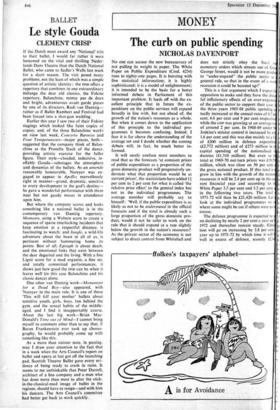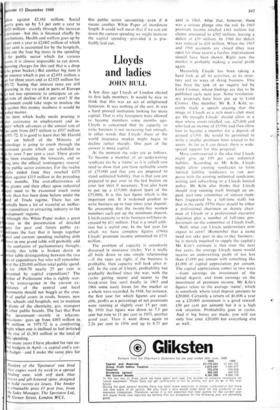MONEY The curb on public spending
NICHOLAS DAVENPORT
No one can accuse the new bureaucracy of not pulling its weight in paper. The White Paper on Public Expenditure (Cmd. 4234) runs to eighty-one pages. It is bursting with fine statistical information; it is highly sophisticated; it is a model of enlightenment; it is intended to be the basis for a better informed debate in Parliament of this important problem. It leads off with the ex- cellent principle that in future the ex- penditure on the public services will expand broadly in line with, but not ahead of, the growth of the nation's resources as a whole. But when it comet down to the application of this principle to the individual pro- grammes it becomes confusing. Indeed, I fear it is far above the understanding of the average MP and I doubt whether the coming debate will, in fact, be much better in- formed.
It will surely confuse most members to read that as the forecasts 'at constant prices of public expenditure as a proportion of the gross domestic product will progressively un- derstate what that proportion would be at current prices', the statisticians have added li- ner cent to 2 per cent for what is called 'the relative price effect' to the general index but not to the individual programmes. The average member will probably say to himself: 'Well, if the public expenditure is as likely as not to be understated in the official forecasts and if the total is already such a large proportion of the gross domestic pro- duct, would it not be safer to work on the rule that it should expand at a rate slightly below the growth in the nation's resources? As the private sector of the economy is not subject to direct control from Whitehall and does not strictly obey the fiscal a monetary orders which stream out of Gre George Street, would it not be more prude to "under-expand" the public sector as general rule, so that in the event of a wor recession it could be boosted up?'
This is a fair argument which I expect t opposition to make and they have the dre ful inflationary effects of an over-expans of the public sector to support their case. the three years 1965-68 public spending a tually increased at the annual rates of 6.7 cent, 6.6 per cent and 9 per cent respective while the GNP was growing at an average ra of around 2 per cent. In 1968-69 under Jenkins's stricter control it increased by o 1.6 per cent and this was due mainly to a 1. of £200 million in defence expendit (£2,772 million) and of £273 million in capital spending of the nationalised dustries (f1,510 million). But even so t total at 1969-70 out-turn prices was £19,5 million, which was close on 50 per cent the gross national product. If this total is grow in line with the growth of the nation resources it will be 2.4 per cent up in the c rent financial year and according to t White Paper 3.5 per cent and 3.2 per cent in the following two years. The total 1971-72 will then be £21,420 million. Let look at the individual programmes to where some might be cut if others were to crease.
The defence programme is expected to A on declining by nearly 2 per cent a year up 1972 and thereafter remain steady. Educ tion will go on increasing by 3.8 per cent year up to 1971-72 by which time it will well in excess of defence, namely £2,
ffolkes's taxpayers' alphabet
A is for Avoidance on against £2,161 million. Social rity goes up by 5.1 per cefit a year to 820 million—mainly through the increase pensions—but this is financed chiefly by tributions. Health and welfare goes up by per cent a year to £2,002 million of which per cent is accounted for by the hospitals.„ se are the four big items in the spending the public sector which for various sons it is almost impossible to cut down. posing charges for this and that is a drop the great bucket.) But another big item is interest which is put at £2,051 million a r for three years and at £2,025 million for 1-72. Seeing that interest rates are still ancing in the us and in parts of Europe it not too optimistic to anticipate an an- Irate of decline of 0.4 per cent? If the ernment could take steps to insulate the against this money madness it would be ther matter.
An item which badly needs pruning is her assistance to employment and in- stry' which advances at the annual rate of per cent from £857 million to £937 million 1971-72. It is good to learn that Mr Harold ter on behalf of the Ministry of echnology is going to comb through the testment grants which are scheduled to by over 5 per cent a year. These grants e been exceeding the forecasts, and so mg into the official 'contingency reserve' the public sector estimates. For the twelve nths ended June they reached £475 Ilion against £315 million in the preceding lve months. The cost-effectiveness of se grants and their effect upon industrial put need to be examined much more rely than has been done before under the d of Trade regime. There has un- ubtedly been a lot of wasteful or ineffec- e expenditure in attracting industry to the selopment' regions.
Although this White Paper makes a great duce in the presentation of detailed res for past and future public ex- tures the fact that it lumps together tal and current spending including debt rest in one grand table will probably add the confusion of parliamentary thought. mainly this table is broken down in ether table distinguishing between the two les of expenditure but who will remember of the £20,000 million total public spend- for 1969-70 nearly 25 per cent is -resented by capital expenditure? The ,tuber of Parliament who is rightly wor- d by extravagance in the current ex- lditures of the central and local ernments should not boggle at the crea- of useful assets in roads, houses, new ,ns, schools and hospitals, not to mention • plants of the electricity, gas, transport F other public boards. The fact that Post ce investment—mainly in telecom- .nications--goes up frofn £403 million ttl, 8 million in 1971-72 is a comforting 'Light when one is inclined to feel irritate4. the rise of £1,363 million in the total of rilic spending.
For many years I have pleaded for tyo na- nal budgets in April-,--a capital and a cur- budget—and I make the 'same, plea for this public sector accounting—even if it meats another White Paper of inordinate length. It could well mean that if we can cut down the current spending we might increase the capital spending—provided it is pro- fitably laid out.















































 Previous page
Previous page